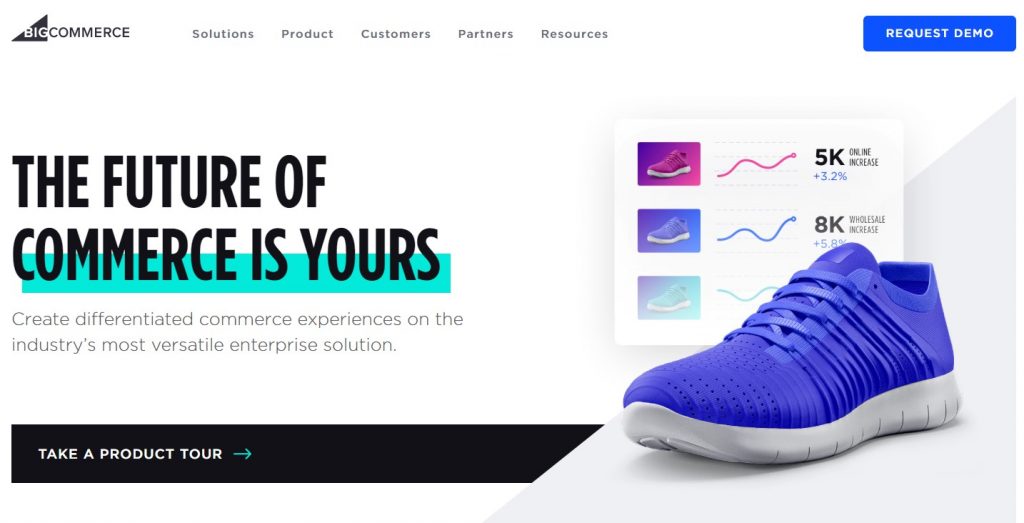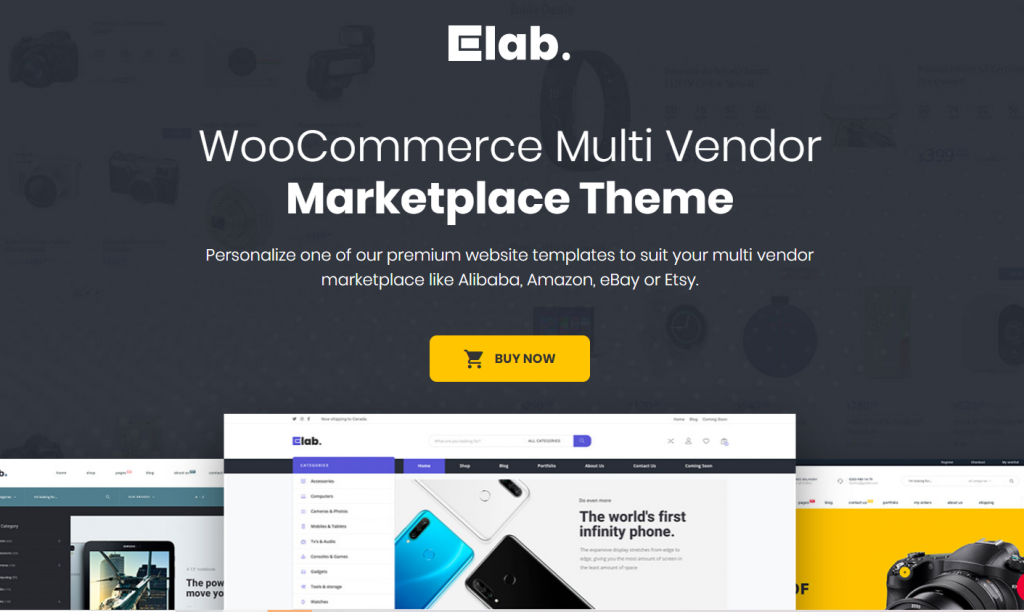Will you be able to find a person who’s never heard about eBay or Amazon nowadays? More likely that the answer is not. Their immense success reached every corner of the Earth. So it’s not a surprise that the idea of building a multi-vendor eCommerce website is so popular. And if you also have a willingness to do this, we prepared a guide for you on how to create a multi-seller site.
What is a Multi Vendor Marketplace
Before getting started, let’s dive a little deeper and define the online marketplace platform more extensively rather than throwing big names. As we see from the term itself, the multi vendor marketplace allows multiple vendors to add and display their products on one eCommerce platform or website. In other words, it is just one site and diversity of products presented by the range of merchants. Each seller has his shop inside the system to add products to.
Probably the first benefit of such a system is the number of items that respond to so many tastes and flavors, which in its term attracts a huge amount of traffic. And a good and constant flow of traffic leads to more sales and revenue increases.
However, there is a long and challenging way preceding success. In this article, we will review the technicalities side of building an eCommerce website.
How to Make Profit With eCommerce Store
You can make money with your store in different ways. There are lots of online business models. But if talking particularly about multi vendor marketplace, then owners usually dealing with the several common scenarios.
The online store owner can make earnings through:
- Subscription or membership fee. Vendors can host their products on your platform for a fixed price of a monthly subscription. So you make a profit by charging a subscription fee from the registered sellers.
- Commissions. This one is used by the eCommerce giants like Amazon and Alibaba. Using this model enables you to charge sellers a certain percentage commission from the product sold. Generally, it ranges from 5 to 20%.
- Payment Processing Charges. If you are assisting the vendors with payment operations, then you can establish a fee for using the payment processor.
- Logistics. Another additional source of revenue for you. Offering logistics and shipping services to vendors either yourself or through the third-party provider may bring you more profit in a way of shipping fees.
- Listing Fee. Charge sellers for listing their products on your website. A well-known eBay follows this model, allowing vendors to sell their products by taking a listing fee from them.
- Advertising. Use your platform as an ad panel. As online marketplaces boast the big amount of traffic, advertisers may consider your site as a good platform to place their commercials.
These were the main models of how you can make a profit running the eCommerce store. However, it is yet not the full list. You can also benefit from dropshipping, affiliate marketing or other popular business models. The main point is not to limit yourself with a single option. Follow different models in a hybrid way to increase the value in the long term.
It is All About the Domain Name
Think carefully about the domain name. Although there is no specific recipe or clear rules, we suggest you follow some simple steps. Identify several keywords that represent your site and idea and browse these options through the domain name generator. If you are 100% sure you can do it yourself, just go for it! If not, select the best option provided by the domain generator. To make sure you picked up the right choice, just keep in mind that your best result should meet the following criteria:
- It should be short and clear to avoid mistyping.
- It has to be memorable, therefore – original and unique.
Unique and creative yet simple things are easy to read and pronounce. In other words, be creative and try to reflect the idea of your project through the name.
Are You Equipped Well?
One of the most important steps is deciding what software to use. The process is becoming more complicated due to thousands of options available. We can create a long list of databases and CMS, but that won’t help unless you define your requirements.
Instead of listing software options, we suggest you write down criteria and features that are most important for you.
This could be:
- Pricing plans
- Level of customization
- Third-party integrations
- Customer support
- Speed and security
Complete the list yourself and check every element while seeking for the best website building platforms.
Find some examples of the most popular online store builders for eCommerce platforms that can meet your requirements.
#1. WordPress + WooCommerce

We can declare WordPress is the most popular website builder. 35% of all websites nowadays are powered by WordPress. As statistics show, there were over 1.94 billion websites on the Internet in January 2019 in general, and 35% of this is made with WP. Can you imagine this number?
Such indicators are reasonable, WordPress is a powerful self-hosted platform with robust features. WP gives you full control over the website.
Even though it is popular among bloggers mostly, you can use it for almost any type of website, and start an eCommerce with WordPress. In that case, there are lots of plugins that come to the assistant, for instance, WooCommerce. A highly customizable plugin that goes with many payment options and a huge number of all possible add-ons and themes for eCommerce.
WordPress will suit you if:
- you want full control over your website
- you want to supplement your site with not eCommerce part like blog and others
- you want to start small and build out your site as you grow
WordPress is a comprehensive website builder that only broadens its functionality due to plugins and additional software.
#2. Shopify

Shopify could be the perfect option for launching an online multi-vendor marketplace. What is good about Shopify is that it does all the work for you. It even offers you its own payment solution – Shopify Payments, though you can add other payment gateways if you want. Moreover, it provides you with full inventory management, unlimited products, tons of designs, effective marketing solutions, and much more.
Nonetheless, this almost perfect eCommerce website builder has its cons.
For start-up projects, Shopify can be a bit of a high cost. This wasn’t a disadvantage until the market wouldn’t be flooded with worthy yet cheaper alternatives.
#3. BigCommerce

Moving on to the smaller competitor of the previous builder – BigCommerce. The platform is focused mostly on online merchants and based on the more intuitive interface. Again, the platform allows concentrating on growing the business, while it handling all the technical part for you. The biggest advantage of BigCommerce is speedy work. Your website will work fast and secure regardless of the traffic capacity.
Another great benefit of it is that it works perfectly on mobile devices. There are mobile themes available, allowing you easily to optimize the shopping cart for mobile devices. We can’t deny that today this is the benefit you cannot go without.
One of the greatest eCommerce solutions to choose from.
Eye-catching Design is Necessary
Design is the first thing your customers see. At this point, they intuitively feel and decide whether to stop by your website or not. Your objective here is to make them trust you and do it by amazing design and user-friendly interface.
The digital market will offer you thousands of all possible layouts and templates, it will attract you with “10 best eCommerce themes” headlines. Ignore it. And here is the reason why. Those 10 best themes were probably used by hundreds of other people, who like you desperately wanted to create something worthy. However, if you follow their example, you will be just one of the hundred and not among the best 10.
Don’t chase after bestsellers, choose among less popular but original products. Think about the details and simplicity, but don’t forget about the trends in web design. Your future customers will appreciate it.
Speed Up Your Website
Kissmetrics report stated that 47% of internet users expect the page to load in less than 2 seconds. More importantly, a 1-second delay in loading speed will probably cost you 7% of conversions. This means if your website takes a lot of time to load, your visitors will be gone even before you’ll have a chance to capture their attention.
What is an acceptable loading time? According to different reports and statistics, an optimal rate is from 1 to 3 seconds. You can use some tools to check the loading speed of your website: GTMetrix, WebPage Test, Pingdom.
If the results are not that good, follow these simple but effective tips on how to speed up your website.
- Compress images
- Remove unnecessary plugins
- Use Caching
Promoting Carefully: Marketing and SEO
Search engines have become imperative in the digital world, especially when it comes to the field of the online marketplace. People should see your platform in the results when they search for products. The challenge here is that you have to optimize your site not only for search engines but for customers and sellers.
Almost every part of the website can be taken into action. Use everything starting from the optimization of content pages and URLs structure, ending with internal and backlinks. To automate the process install plugins like Yoast SEO that will help you do it professionally.
Apart from that, your eCommerce store will not be able to succeed without a proper marketing strategy. Wise promotion is key! Pay attention to modern digital marketing tools for promoting a product. Social media are at the top of this list as well as email marketing. Collaborate with bloggers and influencers and work on public relations in general.
Would You Like a Bonus Hint?

Some of you may already be scared of the scale of work you need to be done. But, there is nothing to worry about, we saved a hint for you that will halve the amount of work. So if you want to make it easier and still have a superb eCommerce website, take a look at eLab – Multi Vendor Marketplace WordPress Theme. eLab is a powerful WooCommerce theme, created by us, the team of StylemixThemes, for multi-vendor electronics stores. It should be mentioned, we are the Power Elite Author on Envato Marketplace and trusted web product creator since 2001.
This is a universal solution for you to stand out and provide a positive shopping experience for your customers. With this theme, you will be able to build a huge platform that will be equal to such giants like Alibaba, Amazon, eBay or Etsy.
What You Will Get
Fast, secure, responsive and beautiful theme will do all the hard work for you. Stunning eLab contains a big number of unique demos, including different layouts for shop inventory pages. This WordPress theme is compatible with WooCommerce and such plugins as Dokan and WC Vendors.
Despite the fact eLab was mainly created for electronic store purposes, you can adjust it for any needs of yours. eLab is supplemented by X builder plugin – a comprehensive plugin for creating page layouts with intuitive drag & drop builder. X builder is designed for both beginners and WordPress experts. It is very easy to understand the configuration for non-professionals and satisfying to find the advanced feature for experienced users.
Add to that the professional tech support, that is live 24/7 and is ready to help you whenever you need it. And also thorough documentation — helpful knowledge base with detailed manuals and video tutorials to guide you throughout the work. eLab is supported with free lifetime updates. One purchase and always new versions of the product with no need for additional fees.
If you want to ease the process of building a multi-vendor eCommerce website, install eLab and get the full package of strong features.
Summary
Building an eCommerce website is not an easy process. In this article, we listed just a few core steps of this hard-working procedure. Use it as a basis and build up according to your goals.
Choose products and equipment that meet the maximum of your requirements and needs. And think like your customers, they are the ones you create a multi-vendor eCommerce store for.





























This is a real eye-opener, Been using Shopify for a while now, but I am not 100% satisfied with it. This is just proof that I need to explore other options.but a common factor among them is dependance on external plugins for enabling diffrent features. There are platforms like storehippo which provide feature like multi vendor, multi store integrated without additional charges.
Very true and thank you for enjoying our post!
very interesting , good job and thanks for sharing such a good information
Thanks for the step by step instructions. Really helpful guide.
https://stalebank.com/unleashing-the-excitement-exploring-amazon-prime-day/
Thank you too!